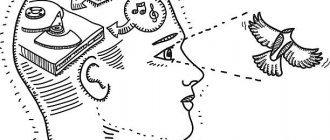During the previous lessons, we learned a lot about the techniques of mass communications that opinion leaders, the media, and other initiators of mass communications use in communicating with the audience.
And in order to fully understand how it all works, you need to delve deeper into such a concept as “mass psychology.” We have already considered some aspects of mass psychology and crowd psychology that are important for impersonal communications.
You already have an understanding of confirmation bias, group identity and group reinforcement, filter bubbles, availability heuristics, and other social biases. And now we will continue to delve into the topic of mass psychology. The purpose of the lesson: to understand how mass psychology works in order to take into account its nuances in interaction with the audience in synchronous and asynchronous communications (questions, answers, comments) as the initiator of communication.
And also learn to understand your reactions to various aspects of mass communications, in which you, willingly or unwillingly, become participants every day. So, let's get started, and first let's clarify what is meant by mass psychology.
Weight
Freud, when contrasting individual and mass psychology, does not find significant differences between them.
At the same time, he emphasizes that the opposition between social and narcissistic mental processes falls within the realm of personality psychology and is not used as a distinctive characteristic to separate personality psychology from mass psychology. Upon initial reading of this thesis, it is not immediately clear what exactly the author means: does it mean our attitude towards members of society or our narcissistic desires? However, he further explains this as follows: the attitude of an individual towards members of society (relatives, friends and loved ones) is an attitude towards a specific individual, and not towards the mass of people as a whole. In mass psychology, this is the influence on a person of relationships with a large number of people (mass) at the same time and as a whole. By an individual he understands a member of a community who, when united with several similar members, turns into a mass. From the point of view of social sciences, one can agree with such a generalization made by the author, since no glaring contradictions are revealed. At the same time, Freud argues with those who highlight significant differences between mass and individual psychological behavior. And at the same time he notes that social phenomena originate in family relationships. Currently, the author's opinion is also supported by the experience of individual and collective psychoanalytic therapy.
In his work, Freud criticizes Le Bon’s works, highlighting a number of contradictions and shortcomings in it:
- Le Bon speaks of a mass, collective soul, which is acquired by individuals who have become members of the mass, while they think and feel differently than they acted and thought individually. That is, according to Le Bon, mass is not the sum of the terms of its components, but some new characteristic. However, Le Bon does not answer the question of what is the connecting link in the mass, what is such a characteristic of the mass?
- Le Bon says that among the masses the racial unconscious comes to the fore. Freud believes that what is exposed is not a racial, but an unconscious foundation, which is the same for everyone.
- Le Bon attaches too much importance to the emergence of new qualities in the masses; Freud, however, does not place emphasis on this, emphasizing the fact that repressions are eliminated in the masses and manifestations of the unconscious come to the fore.
- Although Le Bon mentions in passing the contagiousness of the masses, Freud attaches much greater importance to this phenomenon.
- Le Bon's insufficient distinction between the concepts of infectiousness and increased suggestibility. Fred interprets contagion as the influence of individual members of a mass on each other, and suggestion in a mass is similar to the phenomena of hypnotic suggestion. When describing suggestion, Le Bon also does not mention anything about the suggestive figure - the hypnotist.
- Le Bon does not formulate a description of the figure of the leader of the mass; the patterns of mass formation with the highlighting of the image of the leader are not clearly described. Also not mentioned in his work is a description of the role of the leader and such a phenomenon inherent in the leader as the presence of power or prestige.
- Freud, in criticizing Le Bon, also notes that the mass soul is capable of mental work, making great decisions, and creating works of art.
Summarizing Freud's position regarding Le Bon's work, we can say that Le Bon does not introduce anything new in the description of the concept and manifestations of the mass soul. Also, in his opinion, Le Bon’s view of the inhibition of intellectual activity by the collective and the increase in efficiency among the masses is not new. Freud emphasizes the fact that Le Bon did not describe all the manifestations of the mass soul, and also that these manifestations are of the exact opposite nature. Upon further reading of Freud's work, we can say that he examines in detail the above-mentioned issues, on which he criticizes the shortcomings of his predecessors who study issues of mass psychology.
It is worth noting that Freud expresses sincere surprise at the fact that the most striking phenomenon of a mass is the increase in affectivity caused in each individual member through the so-called emotional contagion. Further on the pages of his work, he pays great attention to this issue.
As a result, Freud notes that there are contradictions in the works on mass psychology, which he will try to eliminate in his work, which he largely succeeds in doing.
Maslow's pyramid
Maslow's pyramid, also known as the pyramid of needs, is a hierarchy of human needs from basic physiological (food, shelter, safety) to higher aesthetic needs and self-actualization needs.
This hierarchy is represented as a pyramid with a wide base and a tapering top. This is how it was presented by the followers of the author of the hierarchical model of human needs, American psychologist Abraham Maslow (1908-1970). Hence the name “Maslow’s pyramid”:
It is interesting that the author of the model himself did not depict a pyramid anywhere. The levels of the pyramid should be considered sequentially from bottom to top from the basic to the highest. We will do just that, simultaneously explaining how each step of the pyramid can be taken into account in mass communications technologies.
Maslow's pyramid in mass communications:
- Physiological needs are the promise of all benefits, a better life, a brighter future, affordable housing.
- The need for security is the rationale for the need for total control over everything and everyone.
- The need for love and belonging to a group (family, society) is an ideal basis for the formation of group identity, group reinforcement, and the imposition of almost any values, if these are the values of the group.
- The need for respect is praising the people, referring to the past merits of ancestors, which allows you to “chat” the topic of today's pressing problems.
- The need for knowledge and understanding is an appeal to the ambitions of young people, the promise of “social elevators”, accessible higher education and other things.
- Aesthetic needs are relevant for the intelligentsia and people who have solved their other problems and now want to join the elite.
- The need for self-actualization is the highest level of needs characteristic of truly creative, selfless individuals.
Abraham Maslow argued that no more than 2% of people reach the stage of self-actualization [A. Maslow, 1943]. A very large number of people spend their entire lives trying to provide basic first and second level needs.
It is these needs that the rulers of all countries and peoples turn to when they need to get the support of the population. Thus, on September 5, 2005, Vladimir Putin, at a meeting with the government, announced three priority national projects: “Housing”, “Health”, “Education”. Now there are more projects, and almost all of them, one way or another, are designed to convince the population that housing, education, healthcare, and other things are about to get better, all that remains is to be patient a little [Government of the Russian Federation, 2021].
It is worth mentioning separately about the second level of Maslow’s pyramid. Safety ranks second in importance, right behind physiological needs. In exceptional cases, when, for example, a person finds himself in a zone of combat or riots, this need may come first. In the normal course of life in society, security is, among other things, a person’s desire to belong to some group, so that his thoughts and ideas are shared by someone else. Which, by the way, was repeatedly confirmed by Asch’s experiments, which we also discussed above.
In a sense, the second level smoothly transitions into the third, which precisely “encompasses” the need for love and belonging to a group. Only in relation to the second level we are not talking about love, but rather about the absence of rejection and social isolation. We have already examined above how this manifests itself in the form of a spiral of silence, social conformity, and appeal to the majority (argumentum ad populum). The direct consequence of all this is acquired helplessness on a societal scale.
Many people are not ready to take responsibility for their lives even when they have the opportunity to do so. In the above-mentioned interview with a refugee from North Korea, there is a valuable idea that it is difficult for people who have lived their entire lives in a socialist society to adapt to a capitalist way.
As the interviewee aptly noted, “The North, at the party level, tells you all your life clearly what you should do, and you don’t make any decisions, but the South forces you to make all the decisions yourself. At first, this is incredibly difficult to understand, accept and apply to life” [R. Super, 2016]. For those interested, let us clarify that the hero of the interview himself had experience in private entrepreneurship, which has been permitted in North Korea since 2002, therefore, after fleeing to South Korea, he was able to adapt to a new life faster than many of his compatriots.
Types of masses according to Freud
By artificial, Freud understands those masses that need external coercion. In this case, attempting to exit is severely punished. The example of such in the modern world is quite diverse, since even now the saying “who is not with us is against us” is quite popular, which is used both among the masses with a simple administrative apparatus, and in more complex and structured ones (for example, political parties) .
The author says that in the church and the army the presence of a supreme ruler is cultivated, who, as is positioned, loves each individual member of the mass with equal love. Freud considers this an illusion, with which we cannot but agree, since otherwise it would be absurd and practically impossible to implement. In his opinion, everything rests on this illusion in the masses. Christ and the General play similar roles to the representatives of the flock and the army. Examples of leadership of the masses by outstanding commanders (Macedonian, Napoleon, Suvorov, etc.), as well as prophets (Jesus, Mohammed) reinforce the conclusions made by Freud in this work.
According to the author, the libidinal factor underlies the unity of members of the mass. Each member of the mass (person) is libidinally connected both with the leader and with other individuals. This thesis can be verified practically by joining any mass under the leadership of a leader, or by remembering examples from history and cinema. At the same time, Freud considers one of the main phenomena of mass psychology to be the lack of freedom in the mass of an individual, which is also supported by examples of personal or observed participation in mass formations.
The phenomenon of mass consciousness
The main difference between a mass and a structured, stable group is the presence of mass consciousness, characterized by disorganization and commonality of experiences. It is embodied in the unification of individual consciousnesses, but does not coincide with each of them separately. Its structure contains emotional-effective (primary) and rational (secondary) levels. The features of the psychology of mass consciousness are determined by the circumstances that give rise to the unity of experiences. Depending on the nature of events, this type of social consciousness can capture more and more new individuals from various social groups, or, on the contrary, it can reduce the mass. Such circumstances include wars, natural disasters, economic crises, political rallies, etc. The highest point of experiencing a problem is a fundamental factor in mass consciousness. Vivid emotions and feelings suppress the usual rules of behavior, norms and values, and there is a need for immediate action.
The properties of mass psychology are distinguished:
- emotionality;
- variability;
- mobility;
- contagiousness;
- heterogeneity.
A little later, a rational level is formed, including publicly available and widely discussed information. This level is divided into 3 blocks:
- People's expectations, assessment of their capabilities to influence the situation.
- Changes in people's opinions and moods in connection with the assessment of the current situation.
- Social values, reflecting the attitude of public consciousness to events.
A manifestation of mass consciousness in action is mass behavior, characterized by situationality and temporality. For example, general panic associated with defeat in the war. The psychology of mass behavior is determined by which level (primary or secondary) will ultimately prevail. If the emotional-effective level predominates, behavior becomes more disorganized and spontaneous, while the rational level becomes more manageable.
Libidinal connections among the masses
Freud pays attention to the aspects of increased affect and decreased mental work in the primitive masses. However, the term “primitive mass” is not entirely transparent, since it can include both the definition of a union (herd) of ancient peoples and modern simple mass formations. It is important for Freud to find a psychological explanation for the mental changes occurring under the influence of the masses, which he practically copes with. For example, in his opinion, the following aspects are not such:
- rational explanations (instinct of self-preservation);
- suggestion (according to Le Bon, McDougall).
Freud has no doubt that we fall into affect, the signs of which we notice in another person. By postulating the presence of affectivity when joining a mass, Freud approaches the concept of libido, thereby avoiding the explanation of mental changes through suggestion on members of the mass.
As we have already encountered, libido is his term from the field of the study of affectivity. However, when this term is introduced in the work, its relationship with mass phenomena is not immediately clear. But further, when the term “affectivity” is mentioned, the picture becomes clearer for the reader. Libido is interpreted by him as the energy of primary urges, as love. Thus, the author synonymizes primary love urges and primary sexual urges.
One should agree with the author’s opinion that love relationships represent the essence of the mass soul, because:
- The mass is united by some force;
- The individual has a need, not a confrontation (i.e., out of love, to act in the interests of the masses).
At the same time, it is difficult to imagine that such a unifying force could be a less powerful, energetically charged force, or a force that has a negative degree of connotation.
Considering the issues of relationships between people in the affective environment, Freud gives the following chain of conclusions:
- There is intolerance of too intimate approach between people and the formation of a sediment of hostile feelings;
- With the formation of a mass and in the mass, the disappearance of such intolerance is observed;
- The disappearance of intolerance as a result of the limitation of narcissism arises from the libidinal connection with other people;
- Such connections are, as the author mentioned earlier, love urges that, without losing energy, nevertheless deviated from the immediate goal.
The logic constructed by the author in his work allows the reader to clarify the general picture of the construction of affective connections in mass formations and agree with the conclusions formulated.
However, considering such a phenomenon as panic, Freud says that affective ties in the mass are broken, and the danger for its members seems significantly higher. From his point of view, panic is the decomposition of the masses (loss of connection with the leader). As a result, cruel and hostile impulses towards other people appear that were not there before. When referring to examples of panic in the army during battles, or masses of people gripped by panic in social and everyday situations in the modern world, the severance of affective ties during panic is an irrefutable fact.
At the same time, the author builds parallels between mass fear (panic) and the neurotic fear of an individual, which in turn is confirmed by his previously formed conclusions.
Identification
Freud develops a mechanism of mass formation based on the principles of identification, as the earliest manifestations of an emotional connection with another person. His findings were supported by the following identification features:
- The emergence of an emotional connection with the object;
- Replacement of libidinal connection;
- The possibility of identification with each newly noticed commonality with a person who is not the object of sexual instincts.
If we take as a basis the initial introductions offered by the author regarding the features of identification, we can agree with the conclusions he formulated that identification is a mechanism for the formation of masses and the formation of emotional connections in it between objects of such masses.
Freud highlighted the difference between identification with the father (who one wants to be) and the object choice of the father (what one wants to possess), while highlighting the ambivalence of feelings: from expressions of tenderness to the desire for elimination. Examples of such identification are currently among the typical issues being worked through when a psychoanalyst works with patients.
Freud also considered identification in the neurotic formation of symptoms and said that identification is devoid of an object relationship to the person being copied (mental infection). The author's opinion regarding mental infection is difficult to comment on in any way, since he does not provide a more detailed chain of reasoning on the basis of which this conclusion was made.
The connection between falling in love, hypnosis and mass formation
The I-Ideal function, which Freud describes, is formed in the following way:
- When falling in love occurs, a psychic capture by the object arises, dictated by sexual primary urges for the purpose of direct sexual satisfaction (base sensual love), thus:
- the object is freed from criticism
- most of the narcissistic libido flows into the object
- There is a replacement of the object of the never achieved I-Ideal (the object takes the place of the I-Ideal).
At the same time, Freud connects the concepts of hypnosis, falling in love and mass formation. He provides evidence that falling in love is close to hypnosis; the hypnotist has taken the place of the Ideal Self. At the same time, one cannot but agree with the logic and conclusions of the author. Freud emphasizes that since falling in love is similar to hypnosis, and a hypnotic connection is the formation of a mass of two persons, in this way he connects mass formation and falling in love. In this case, the formation of masses occupies an intermediate position between hypnosis and falling in love:
[Falling in love ←Education of the masses → Hypnosis]
Considering libido, the replacement of the I-ideal, and falling in love, Freud derives a formula for the libidinal constitution of the mass, which summarizes his reasoning about the logic of constructing masses in connection with the functions of the “I.”
Mass and primitive horde.
Considering the mass, Freud proves the fact that the logic of constructing the mass is similar to the process of constructing and functioning of the primitive horde:
- Regression of mental activity to an earlier stage (what is typical for savages and children);
- The individual is at the mercy of the attitudes of the mass soul. In this case, a suggestive influence is exercised: not only from the leader, but also from each individual on each other individual;
- Implementation of the identification process: the formation of such social feelings that are based on changing initially hostile feelings into a connection in a positive direction.
The above characteristics are also inherent in such a formation as a primitive horde (based on descriptions by historians and anthropologists).
At the same time, Freud criticizes the opinions formed before him that the herd instinct is indecomposable, primary as an instinct of self-preservation (objection to Trotter). Trotter also assumes that the mental phenomena necessary for the masses originate in the herd instinct, as a continuation of multicellularity. In his opinion, an individual feels incomplete if he is alone.
Trotter considers the fear of a small child as a herd instinct, and Freud claims that this fear is addressed to the mother. On this issue, one should agree with Freud's justification in connection with later discoveries made in the psychoanalysis of children, as well as based on practical observation of the behavior of children when communicating with their mother or members of the masses (for example, social communities).
Thus, Freud modifies Trotter’s statement that man is a herd animal to the fact that “man is an animal of the horde, an individual led by the leader of the horde.” These conclusions are based on the author’s previously mentioned conclusions regarding the logic of mass formation and the processes of formation of libidinal connections in the masses.
How to protect yourself from manipulation?
An individual ceases to control his behavior as soon as he gets into the crowd and becomes himself again as soon as he leaves it. You can fully realize your potential, reveal your talent, and bring benefits only through individual activity. But there is a problem: one in the field is not a warrior. There is only one way out - do not succumb to outside manipulation.
Forewarned is forearmed. Here are 9 popular psychological techniques that subtly but surely influence people.
Presupposition.
This is one of the most used NLP models, which allows speech to create “a reality in which only the desired behavior options exist.” Presupposition helps to gently convince a person that something will definitely happen.
For example, a politician agitates voters: “When I am president, I will do...”. And he doesn’t even discuss the option that this won’t happen.
Flattery.
A simple but effective “below the belt” technique, with which the manipulator tries to put the other in a good mood and use it to his advantage. Here we work on the opponent’s self-esteem: compliments, encouragement, words of gratitude.
For example, a manager convinces employees to go to work on a day off: “I know that you are responsible workers, so you can spend your day off and do urgent work.”
Pre-selection.
It works on the principle: choose the lesser of two evils. On the one hand, there are no prohibitions and there is the right to choose. But on the other hand, there are no other answer options other than those proposed.
For example, in advertising we are asked: “Do you choose Fanta or Sprite (burger or cheeseburger)?” Although both brands belong to the same manufacturing company.
Inspiration.
Inspiration helps you work tirelessly, make discoveries, and believe in your superpowers. So when manipulators want to persuade someone to achieve a feat, they organize inspiration for him.
For example, before a battle, the commander tells the soldiers: “What you are doing is necessary! You will succeed! Everything for peace on earth!”
Emotional attack.
Playing on emotions is a simple way to get the right actions from employees, relatives, and friends. This is repeated repetition of the same demands, a change in intonation, an attempt to promote feelings of guilt.
For example, a teacher shames the class: “I treated you like adults, but you let me down. Do you know how the director scolded me because of you?”
Social proof.
The so-called herd instinct is remembered by most residents of the Soviet Union, who stood in line only because it was a symbol of scarcity. “If everyone takes it, it means it’s a good thing,” thinks a person who does not want or does not have time to understand the situation.
For example, when people want to choose from a large number of gadget models, they rely on ratings and reviews. And they don’t even think that reviews are written by “their” employees from the manufacturing company.
The principle of mutual exchange.
The rule says: a person needs to return good for good. And since any obligations are depressing, you want to get rid of them as quickly as possible. Skilled manipulators take advantage of this - they provide a small service and wait for a response.
For example, religious sectarians hand out free literature on the street, and in return ask to listen to their instructions.
Motivation by fear.
Fear is a powerful human emotion and a sure-fire motivator. Therefore, in order to force a person to do something, you need to scare him properly “in advance”: talk about a future car breakdown or warn him about an article for theft.
For example, the work of insurance companies is based on intimidating people - the more intimidating examples are given, the more often insurance policies are purchased.
Clarification of the mechanism of hypnosis
After clarifying the mechanisms of mass formation and the basics of hypnosis, Freud demonstrates how it functions in a mass using the example of a primitive horde:
- Freud's starting premises:
- The mass is a newly revived primitive horde;
- Mass psychology is the oldest psychology of humanity;
- Love limits narcissism;
- The forefather forces his “sons” to abstinence, that is, to mass psychology;
- The hypnotist steals the will of the subject, has the power of animal magnetism, which is taboo among primitive peoples.
- Freud's explanation of the mechanism of hypnosis using the example of a horde:
- Demonstration of love. In the primitive horde, the illusion is maintained that the leader loves everyone in an even and fair manner (an idealistic reworking of the conditions of the primitive horde: all sons knew that they were equally persecuted by their father and were equally afraid of him).
- Concentration/stealing will. The hypnotist, like the leader of the horde, demands to look into his eyes, which is difficult to bear. He avoids directing the subject's conscious thinking towards his intentions. The subject concentrates his attention on the hypnotist, establishing a connection with him and a readiness to endure internal processes.
- Awakening fear of the parental figure. During hypnosis, the subject awakens part of his archaic heritage, which also manifested itself in relation to his parents. At the same time, the subject’s idea of a super-powerful and dangerous person came to life. A similar attitude of the primitive man of the horde to the forefather.
Based on the conclusions made earlier, I would like to note that Freud explains the compulsory nature of mass formation, incl. the origin of the primitive horde with the help of hypnosis (suggestion), based not on mental work, but on an erotic connection, which does not coincide with the conclusions made earlier by his predecessors. However, the logic of reasoning and the presentation of evidence allows us to agree with the author’s opinion.
Psychology of Mass Communications
Mass communication is the process of producing information and distributing it to wide, anonymous, dispersed audiences. The Soviet and Russian scientist Grushin, within the framework of the study of this type of communication, identifies 5 functions:
- Informational. Acts as the main task.
- Socialization. The function is aimed at forming and changing the intensity of attitudes and values of the audience.
- Organization of behavior. This function is associated with inducing the audience to take action or stopping it or changing it.
- Creation of emotional and psychological tone.
- Communication. Involves strengthening, maintaining or weakening communication ties between different audiences.
The most striking example of mass communications is the Internet.
From the point of view of mass psychology, this phenomenon is aimed at the formation of mass psychology, the formation of the masses as a subject of social action.
The psychology of mass communication studies the characteristics of the psyche of people included in the space of this type of communication.
Stage in the constitution of the human self
As one might assume after reading this chapter of Freud's work on the masses, he talks about the processes of formation of the human “I”. This chapter is, in our opinion, the most difficult to analyze in terms of its logic and the formation of conclusions.
As the author notes, among the masses, the individual person abandons his “I-ideal” and replaces it with the mass ideal embodied in the leader. Further, he reduces the explanation of the libidinal structure of the mass to the difference between the I and the I-ideal and a double type of connection: identification and replacement of the I-ideal with an object. The “I” becomes an object in relation to the “I-ideal” that has developed from it. Then, in the process of human development, the mental world is divided into a coherent “I” and an unconsciously repressed part. The stability of which is subject to constant shocks. Unfortunately, the lack of examples and explanations does not allow us to agree or refute this series of conclusions. However, Freud's works continue to be built on this division, which suggests that he did not abandon his conclusions over time.
According to the author, the separation of “I” and “I-ideal” cannot be endured for a long time and at times the reverse process must take place. He also considers the process of the coincidence of anything between the Self and the Self-ideal, which is a triumph for the Self.
Freud discusses the mechanism of alternation between mania and melancholia. The ideal self of such people dissolves into the “I”. In the case of mania, the “I” and the “I-ideal” merge. The misfortune of a melancholic person is a split between the instances of the “I”, in which the ideal condemns the “I”. At the same time, the author raises the question of whether one should look for the reason for the changed relationship between the “I” and the “I-ideal” in periodic indignations against the new institution or whether it depends on other reasons and comes to the conclusion that the transition to mania is not necessary in melancholia and vice versa.
Summarizing the above, we can note the fact that although Freud mentions the complex mechanism of the constitution of the “I” and its division into the “I-ideal”, however, he does not provide sufficient examples and more detailed logic of reasoning that would allow us to trace the conclusions he made and inferences.









